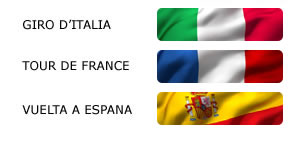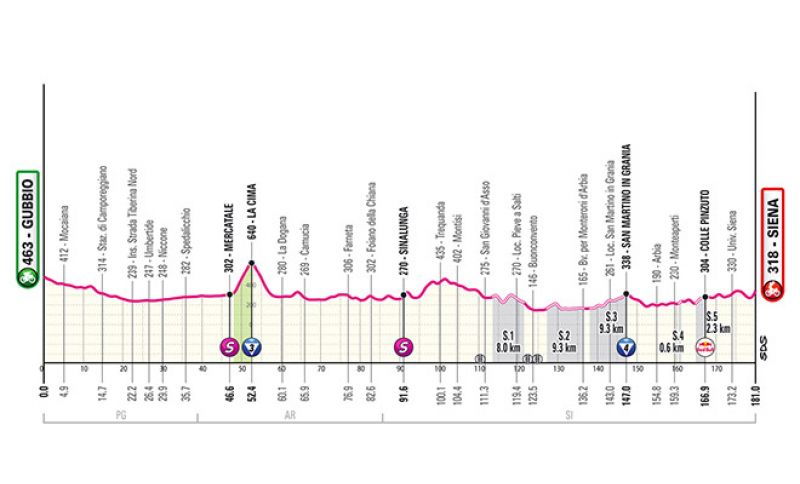

Among all the stages of the first half of the Giro d'Italia, today's stage is certainly the most feared by riders and the most anticipated by fans. The Gubbio-Siena is indeed the gravel road stage. Of the 181 kilometers to be covered, 29 are on the white roads of Siena, divided into five sectors.
to follow the live coverage of the entire stage starting at 12:55 CLICK HERE
From Gubbio, the route approaches the Sienese territory through Cortona and Sinalunga on a fairly wide road with many changes in direction and gradient. After San Giovanni d'Asso, the Pieve a Salti gravel section (8.0 km) is challenging, undulating, very nervous with many curves and ups and downs. After the second passage through Buonconvento, the Serravalle sector (9.3 km) is tackled, which ends just before the start of the next sector (San Martino in Grania, 9.4 km) in the midst of the Sienese clay hills. Arbia is crossed to reach the brief Monteaperti section of only 600 m, but with a gravel climb with double-digit gradients. Asphalt is found again until the entrance to the final gravel section at Colle Pinzuto (2.4 km with gradients up to 15%). Once out, the route heads towards Siena for the final city kilometers that wind for the first part outside the Siena urban area on wide roads and long straights connected by wide curves, first downhill and then on a slight uphill until 2 km from the finish where Via Esterna di Fontebranda is taken with gradients up to 9%. At 900 m from the finish, Porta di Fontebranda is passed and the cobblestone pavement begins. The gradient exceeds 10% until reaching around 500 m from the finish, in Via Santa Caterina, with peaks of 16%. A sharp right turn follows into Via delle Terme and entry into Via Banchi di Sotto. From 300 m the road is always slightly downhill and leads to the spectacular and scenic finish at Piazza del Campo.
THE TERRITORY. Remarkable monuments from very different eras tell with their bold beauty the history of Gubbio, the starting point of the ninth Giro stage. The reference point for visitors is Palazzo dei Consoli, an imposing Gothic building from the 14th century, which with its majestic facade dominates Piazza Grande, one of Italy's first suspended squares. The view of the valley stretching at the foot of the city from here is extraordinary, but it's worth taking a journey through time to breathe the ancient atmospheres of the medieval quarters, admire the Renaissance Palazzo Ducale and, just outside the center, the Roman Theater (1st century BC) still used for shows and reenactments. The walk also allows admiring the workshops of ceramic masters who for at least nine centuries have been the main protagonists of Gubbio's craftsmanship.
An activity historically widespread throughout the region, so much so that the Umbrian Ceramic Road was created to celebrate and support the work of artisans who have never ceased to perpetuate a tradition of the highest artistic level. Along the Ceramic Road is also Umbertide, located on the race route just over 20 kilometers from Gubbio. A mandatory stop, therefore.
The passage through Tuoro sul Trasimeno offers moments of relaxation on the shores of the largest lake in Central Italy, then entering Tuscany. The race awaits glittering lands: Arezzo and its province are indeed one of the world's most renowned goldsmith art poles. This has been happening since the very distant times of the Etruscans. From one jewel to another, albeit of a very different genre. Sinalunga is the birthplace of the Chianina breed, an excellence in livestock: the authentic Florentine steak can only be prepared with this meat. The midday gastronomic stop could worthily be made here.
From one flavor to another. San Giovanni d'Asso is one of the Italian capitals of Truffle, to which it dedicates an original museum set up in the underground rooms of the 14th-century San Giovanni Castle. Just outside the town, the first of the gravel sections that characterize the final stage is encountered. These are the famous White Roads of Siena, which will put the riders to a hard test. For everyone else, it's the spectacle of the Crete Senesi, with their scenic succession of clay ridges and gullies capturing attention for many kilometers.
Here, finally, is Siena with its extraordinary artistic and cultural heritage. Piazza del Campo, famous for its shell-like shape, the Palazzo Pubblico, and the majestic Torre del Mangia is the mandatory passage point, even for those who have been to this city many times before. Then it's nice to wander aimlessly, with wonders suddenly appearing around every corner. To dive into the authentic soul of the city, however, one must visit at least one of the contrada museums. There are 17, scattered in the City Thirds of San Martino and Camollia. But finding just one is enough to touch firsthand the love of every Sienese for their city: whatever the colors of their contrada.
